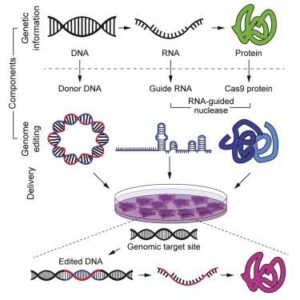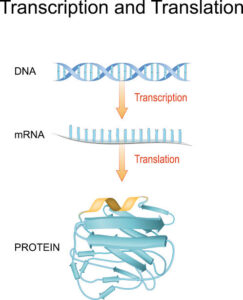Back to: MICROBIOLOGY 100 LEVEL
Welcome to class!
Hello brilliant mind! I’m so happy to have you here again. Your learning journey keeps getting more exciting, and today, we’re going into something that’s like the instruction manual of life—DNA, RNA, and proteins in microorganisms. These tiny molecules play big roles in how microbes grow, behave, and even cause disease. Don’t worry, we’ll make it simple, relatable, and very Nigerian!
DNA, RNA, And Proteins In Microorganisms
DNA in Microorganisms
DNA (Deoxyribonucleic Acid) is like the “chief planner” in a microorganism’s cell. It carries the genetic information that tells the microbe how to grow, divide, and survive. Think of DNA as the original blueprint or agbada design in a tailor’s shop—it holds all the patterns the tailor (cell) will follow.

In bacteria:
DNA is usually found in a single circular chromosome floating in the cytoplasm.
Some bacteria also have extra small DNA pieces called plasmids, which can carry special abilities like antibiotic resistance.
DNA controls everything the microbe does, from making food to fighting medicine. It’s made up of units called nucleotides, and the order of these determines what traits the microbe will have.
RNA in Microorganisms
RNA (Ribonucleic Acid) is like the messenger boy who delivers the instructions from the DNA to the part of the cell that makes proteins. Without RNA, DNA would be like a recipe locked in a cupboard—useless.
There are 3 main types:
mRNA (messenger RNA) – carries instructions from DNA.
tRNA (transfer RNA) – helps gather the materials needed.
rRNA (ribosomal RNA) – forms part of the ribosomes, the protein-making machine.
So, RNA helps to “translate” the message in DNA into something useful for the cell.
Proteins in Microorganisms
Now that the message has been delivered, the cell gets to work and produces proteins. Proteins are the workers of the cell. They do all the important jobs—building structures, breaking down food, defending the cell, and more.
Examples:
Enzymes – proteins that speed up reactions, like breaking down sugar.
Toxins – some harmful bacteria produce toxic proteins that cause diseases.
Transport proteins – help move nutrients in and out of the cell.

Think of a local bakery:
The DNA is the secret recipe written by the bakery owner.
The RNA is the baker’s apprentice who reads the recipe aloud.
The proteins are the bakers who actually bake the bread, mix the ingredients, and sell it to customers!
Summary
- DNA holds the genetic instructions and is usually circular in microbes.
- RNA carries the message from DNA and helps in protein production.
- Proteins are made based on DNA instructions and carry out many functions.
- Together, DNA, RNA, and proteins are like a team that runs the cell—planning, communicating, and doing the work.
Evaluation
- What is the role of DNA in microorganisms?
- Name the three types of RNA and their functions.
- What are proteins used for in microbial cells?
- What is a plasmid?
- Use your own example to describe the relationship between DNA, RNA, and proteins.
You’ve just unlocked one of the most important parts of biology. Every microbe, no matter how tiny, depends on these molecules to live and function. With Afrilearn, you’re mastering knowledge that builds your future step by step. Keep believing in yourself—you were made for greatness!
